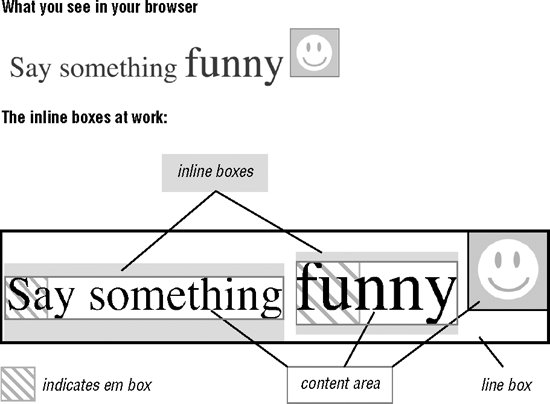Section 19.1. The Box Model, Revisited
19.1. The Box Model, RevisitedAccording to CSS, every element in a document, both block-level and inline-level, generates a rectangular box called an element box. Figure 19-1 shows all the areas and boundaries defined by the CSS box model. At the core of the element box is the content itself, called the content area. Its sides are referred to as the inner edges of the element box. The width and height of an element are calculated as the distance between these inner edges. The padding is the area held between the content area and an optional border. The border is one or more lines that surrounds the element and its padding. Background colors and images applied to an element are visible in the padding and extend behind the border (if there are gaps in the border style, the background color will show through). Finally, on the outside of the element border, there is an optional amount of margin. The margin area is always transparent, which means that the background of the parent element shows through. The outside edges of the margin area make up the outer edges of the element box. The total width that an element box occupies on the page is measured from outer edge to outer edge and includes the width of the content area plus the total amount of padding, border, and margins . Keep in mind that when you specify the width value for an element, that sets the width of the content area only, so there's some extra math to do before you know the total width of the element. This calculation may be critical for positioning elements precisely on a page. Here is where the IE/Windows box model problem comes into play. With the exception of IE 6 and 7 in Standards mode, Internet Explorer for Windows Figure 19-1. The box model applies the width property to the entire width of the element box, from outer edge to outer edge. When margins, borders, or padding are also applied, this results in potentially large discrepancies between how the element should be sized and how it will appear in IE/Windows. 19.1.1. Inline BoxesThe element box is not the only implied box in the CSS visual formatting model. Every character and element in a line of text also generates a box on the fly. These inline boxes are used by the user agent (the browser) behind the scenes to calculate the height of each line in the flow of text and the space around elements. Line boxes and inline boxes are not elements, they are merely a device of the visual layout model. Therefore, you cannot use a selector to target line or inline boxes and apply styles to them (you can apply styles to inline elements, of course). Having a familiarity with the various inline boxes at work behind the scenes is useful for predicting and controlling line height as well as for specifying the vertical alignment of inline elements. They also come into play when specifying box properties, particularly to inline elements. Figure 19-2 highlights the various inline boxes for a line of text. The four invisible boxes that the user agent keeps track of when formatting each line of text include:
In the sections that follow, we'll see how the line box (the total height of a line) is affected (or not affected) by the addition of margins, borders, and padding on inline elements. |
EAN: 2147483647
Pages: 325
